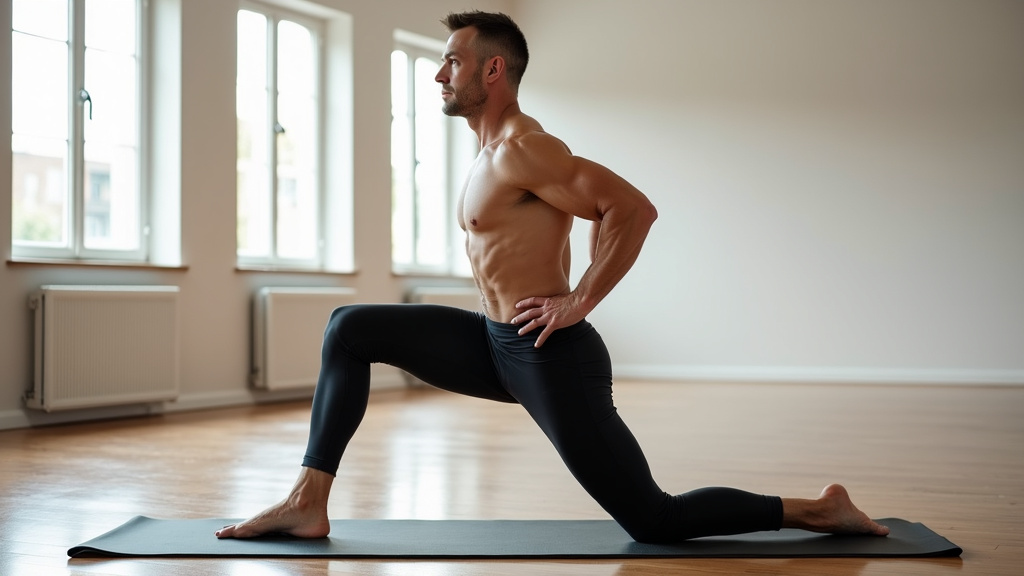While hitting the weights and crushing cardio sessions might be your go-to workout routine, there’s a crucial component many men overlook – mobility training. Think of mobility as your body’s ability to move joints actively through their full range of motion, combining strength, control, and flexibility in perfect harmony.
Let’s clear up a common misconception right away – mobility isn’t the same as flexibility. According to Harvard Health, flexibility is just one piece of the mobility puzzle, focusing on how far your muscles can stretch. Mobility, however, encompasses the complete package of joint movement, muscle control, and functional strength.
For those who spend hours at a desk or behind the wheel, mobility training isn’t just another fitness trend – it’s essential. Imagine reaching for your gym bag without shoulder pain or playing with your kids without worrying about tweaking your back.
Why Every Man Needs Mobility Training
First and foremost, mobility training significantly reduces your risk of injury. When your joints move freely and muscles work efficiently, you’re less likely to strain something during your weekend warrior activities or daily tasks.
Better mobility translates directly to improved athletic performance. Whether you’re into powerlifting, basketball, or golf, having full range of motion in your joints means more power, better technique, and enhanced overall performance.
Joint health is a vital benefit that becomes increasingly important as we age. Regular mobility work keeps your joints lubricated and functioning smoothly, helping prevent the stiffness and discomfort that many men accept as inevitable with aging.
Mobility training also contributes to better posture and movement patterns. This means less back pain, fewer headaches, and more efficient movement in everything from your deadlifts to your golf swing.
Perhaps most importantly, enhanced mobility means greater independence and quality of life as you age. It’s your insurance policy against becoming that guy who can’t pick up his grandkids or needs help getting out of a chair.
Incorporating Mobility Into Your Routine
The beauty of mobility work is that it doesn’t require fancy equipment or hours of your time. Simple exercises like shoulder circles, hip openers, and ankle rotations can make a significant difference when done consistently.
Dynamic movements that mimic real-life activities are particularly effective. Think about squats, lunges, and rotational movements that challenge your joints through their full range of motion while building strength and control.
For optimal results, aim to include mobility work before your regular workouts. This primes your joints and muscles for the work ahead, reducing injury risk and improving performance.
Remember that mobility training isn’t just about going through the motions. Focus on control and quality of movement rather than rushing through exercises or pushing beyond your comfortable range.
Listen to your body and progress gradually. While some discomfort is normal when working on mobility, sharp pain is a sign to back off and potentially consult a fitness professional or physical therapist.
Essential Mobility Exercises for Men

Maintaining proper mobility is essential for preventing injuries, improving athletic performance, and ensuring optimal body function during daily activities. These targeted mobility exercises address common areas where men typically experience tightness and restrictions.
Hip Mobility Fundamentals
Your hips serve as the foundation for nearly every lower body movement, from walking to heavy lifting. Poor hip mobility can lead to compensatory patterns and increased stress on your lower back and knees.
One highly effective exercise is the standing hip flexion drill. Stand tall, lift one knee toward your chest, and hold it with both hands. Maintain this passive stretch for 30-60 seconds before transitioning to an active hold.
The 90/90 hip mobility exercise targets both internal and external hip rotators. Sit with one leg bent forward at 90 degrees and the other leg positioned to the side, also bent at 90 degrees. Keep your spine tall while alternating between leaning forward and rotating toward your back leg.
For desk workers especially, the half-kneeling hip flexor stretch is essential. Kneel with one foot forward in a lunge position, slightly tuck your pelvis, and engage your core while leaning forward to feel a deep stretch along the front of your hip.
Lower Back Mobility Essentials
A healthy, mobile spine forms the cornerstone of unrestricted movement. Many men develop lower back stiffness from prolonged sitting and improper lifting mechanics.
Cat-cow stretches provide an excellent foundation for spinal mobility. Begin on your hands and knees, alternating between arching and rounding your back while breathing deeply through each movement pattern.
The child’s pose with lateral reaches targets both spinal flexibility and side body lengthening. Kneel on the floor, sit back on your heels, extend your arms forward, then slowly walk your hands to each side.
Thread-the-needle rotations help improve thoracic mobility while supporting lower back health. Start in a quadruped position, reach one arm under your body, then reverse the movement reaching toward the ceiling.
Shoulder Mobility Enhancement
Shoulder mobility issues can significantly limit your ability to perform overhead movements and maintain healthy posture. These exercises help restore natural range of motion.
Begin with arm circles to warm up the shoulder complex. Start with small circles and gradually increase the size, performing both forward and backward rotations for 30-60 seconds in each direction.
The cross-body shoulder stretch targets the posterior deltoid and rotator cuff. Bring one arm across your chest, using your opposite hand to gently pull the arm closer to your body. Hold for 15-30 seconds per side.
Incorporate these mobility exercises into your routine 3-5 times per week to improve movement quality and reduce injury risk. Move slowly and mindfully through each exercise, focusing on proper form rather than speed.
Incorporating Mobility Work into Your Fitness Routine
Mobility training serves as the cornerstone of a well-rounded fitness program, yet many people overlook this crucial component. Think of mobility work as the oil that keeps your body’s machinery running smoothly – without it, even the most impressive engine will eventually break down.
Just as regular maintenance keeps your car running optimally, your body needs consistent mobility work to maintain peak performance. Let’s explore how to effectively integrate these essential movements into your existing workout routine.
When to Perform Mobility Work
According to physical therapy experts, mobility exercises can be performed at various times throughout your day. You can treat them like “movement snacks,” as suggested by certified strength specialist India McPeak, performing a few moves when you wake up, during lunch breaks, or before bed.
For workout-specific timing, you have two primary options. First, use mobility work as a dynamic warm-up before training to prepare your body for the movements ahead. Alternatively, incorporate it into your cool-down routine to reduce muscle soreness and speed recovery.
If you’re training for a specific sport or activity, focus on mobility exercises that target the joints and muscle groups most relevant to your chosen discipline. This targeted approach helps optimize your performance while reducing injury risk.
Frequency and Progressive Development
When starting a mobility routine, consistency trumps intensity. Begin with two to three mobility sessions per week, gradually building up to four or more as your body adapts. Even five to ten minutes daily can yield noticeable improvements in your range of motion and overall movement quality.
For optimal results, focus on quality over quantity. Master basic movements before progressing to more challenging variations. This methodical approach ensures you develop proper form and body awareness while minimizing the risk of injury.
Signs of Progress and Advancement
Tracking your mobility improvements requires attention to subtle changes in your body’s capabilities. Notice how movements that once felt restricted become more fluid and comfortable. Observe whether you can achieve greater ranges of motion without assistance or external support.
As your mobility improves, you’ll find everyday tasks becoming easier. Activities like reaching overhead or squatting down feel more natural and require less effort. These real-world improvements indicate successful progression in your mobility work.
Common Mobility Training Mistakes to Avoid
While enthusiasm for mobility work is admirable, avoid the temptation to progress too quickly. Master fundamental movements before advancing to more complex exercises. Remember, mobility training is a journey, not a race.
Don’t overlook the importance of breathing during mobility work. Proper breath control helps your body relax into new ranges of motion and signals to your nervous system that these positions are safe to explore.
| Week | Focus Area | Day 1 | Day 2 | Day 3 | Day 4 |
|---|---|---|---|---|---|
| Week 1 | Hip Mobility | Kneeling Hip Flexor Stretch | Active Hamstring Stretch | World’s Greatest Stretch | Hip 90-90 |
| Week 2 | Back Mobility | Child’s Pose | Prone Press-Up | Cat-Cow | Supine Lumbar Rotation |
| Week 3 | Upper Back and Neck Mobility | Thoracic Extension | Supine Twist | T-Spine Rotation | Thread the Needle |
| Week 4 | Shoulder and Wrist Mobility | Shoulder CAR | Cross-Body Shoulder Stretch | Wrist Flexor Stretch | Wrist Extensor Stretch |
Mobility Workouts for Men Over 40

Physical fitness takes on new meaning after 40, when mobility becomes crucial for maintaining quality of life and preventing injuries. Your body now requires thoughtful preparation before exercise – quick warm-ups no longer suffice.
According to Men’s Health expert David Jack, creator of the Muscle After 40 program, mobility drills offer more effective preparation than traditional static stretching. These exercises activate muscles and enhance range of motion specifically for the workout ahead.
Mobility work is essential for addressing common midlife challenges like lower back discomfort, stiff hips, and reduced flexibility. A well-designed routine maintains athletic performance while minimizing age-related limitations.
Essential Mobility Foundations
A well-rounded mobility practice should focus on key areas that often become problematic after 40: the hips, spine, shoulders, and ankles. These joints frequently bear the impact of sedentary work habits and natural aging processes.
Before beginning any workout, dedicate 5-10 minutes to dynamic stretches targeting your trouble spots. Focus on areas where you typically experience stiffness or discomfort.
Core stability plays a crucial role in mobility work, protecting the spine and enabling fluid movement patterns. A strong core foundation supports better posture and reduces lower back strain.
Lower Back Pain Prevention
Lower back pain affects many men over 40, but targeted mobility work can prevent and alleviate this issue. Choose exercises that promote spinal health without adding unnecessary stress.
The transverse abdominis pushdown, a gentle core-strengthening move, stabilizes the spine while improving mobility. This exercise builds a solid foundation for more dynamic movements.
Bird-dog exercises enhance stability and mobility by challenging balance while strengthening core and back muscles. These movements promote proper spinal alignment during daily activities.
Recovery and Progression
Recovery becomes vital after 40, as your body needs additional time to adapt and heal between workouts. Pay attention to your body’s signals and adjust your mobility routine accordingly.
Begin with basic movements and progress gradually to more challenging variations as your mobility improves. This methodical approach prevents injury while developing lasting flexibility.
Remember that consistency outweighs intensity in mobility work. Regular, moderate practice produces better results than occasional, aggressive sessions that risk setbacks.
Conclusion: Embracing Mobility for Lifelong Fitness
As explored throughout this guide, mobility training offers far more than increased flexibility. It’s a fundamental component of men’s fitness that transforms physical capabilities and enhances overall quality of life.
The benefits of consistent mobility work extend from enhanced range of motion and reduced injury risk to improved athletic performance and decreased muscle soreness. Mobility training effectively combats the natural effects of aging, helping maintain activity and capability throughout life.
Whether you’re an athlete optimizing performance or someone seeking independence and comfort in daily activities, mobility training provides a path to better movement and reduced pain. The key is starting small and remaining consistent – even 5-10 minutes of daily mobility work yields significant improvements over time.
Your joints and muscles deserve the same attention you give to strength training and cardio. By incorporating mobility exercises into your routine, you’re investing in your body’s long-term functionality and resilience. Remember, mobility extends beyond touching your toes – it’s about moving freely, confidently, and pain-free through life’s activities.
The journey to better mobility starts with a single stretch. Begin today by adding simple mobility exercises to your warm-ups or cool-downs. Your future self will thank you for the gift of continued strength, flexibility, and freedom of movement well into your later years.







